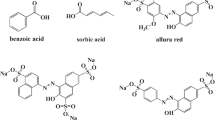Abstract
The characteristics of bias caused by split-flow electrokinetic injection (SEKI), a new type of sample injection method used in coupled flow injection-capillary electrophoresis system (FI-CE), was investigated using pseudoephedrine hydrochloride, a basic drug, and ibuprofen, an acidic drug, as model analytes. It was found that bias imposed by SEKI under the condition of continuous sample matrix/running buffer was similar to that done by electrokinetic injection (EKI). The linearity of calibration curve provided by SEKI was similar to that offered by non-bias hydrodynamic injection (HDI) but significantly better than that obtained by EKI. These features were exploited to improve analytical performances in simultaneous determination of the minor ingredient of pseudoephedrine hydrochloride and the major ingredient of ibuprofen in a pharmaceutical preparation. Detectability of 0.7 mg/l for pseudoephedrine hydrochloride was achieved at a sample throughput rate of 24 times per hour, which is 30% lower than that obtained by HDI-based conventional CE. Relative standard deviations (RSDs) of 2.8% for the minor ingredient and 1.2% for the major ingredient were produced in 11 runs of a test solution containing 13.1 mg/l pseudoephedrine hydrochloride and 81.4 mg/l ibuprofen. This is an improvement compared to that obtained by HDI-based conventional CE. Analytical results for two batches of compound ibuprofen tablets by the SEKI-based FI-CE approach were in good agreement with that obtained by a conventional high performance liquid chromatographic method.
Similar content being viewed by others
References
Krivacsy Z., Gelencser A., Hlavay J., Kiss G. and Sarvari Z., Electrokinetic injection in capillary electrophoresis and its application to the analysis of inorganic compounds, J. Chromatogr. A, 1999, 834(1/2): 21–44
Fang Z. L., Liu Z S. and Shen Q., Combination of flow injection with capillary electrophoresis. Part I. The basic system, Anal. Chim. Acta, 1997, 346(2): 135–143
Liu Z S. and Fang Z. L., Combination of flow injection with capillary electrophoresis. Part 2. Chiral separation of intermediate enantiomers in chloramphenicol synthesis, Anal. Chim. Acta, 1997, 353(2/3): 199–205
Chen H. W and Fang Z L., Combination of flow injection with capillary electrophoresis.: Part 5. Automated preconcentration and determination of pseudoephedrine in human plasma, Anal. Chim. Acta, 1999, 394(1): 13–22
Luo J W., Chen H W. and He Q. H., Determination of cimetidine in human plasma by use of couple-flow injection, solid-phase extraction, and capillary zone electrophoresis, Chromatographia, 2001, 53(5/6): 295–300
The Pharmacopoeia Commission of the Ministry of Health People’s Republic of China, Drug Standard of Ministry of Health (NO: WS-308(X-263)-95), 1995, 1–3
Chen H. W., Huang D. H., Chen Q. J. and Li H. L., Rapid determination of active constituents in compound ibuprofen tablets by capillary zone electrophoresis, Chinese J. Chromatogr., 1998, 16(4): 289–292
Chien R. L. and Burgi D. S., On-column sample concentration using field amplification in CZE, Anal. Chem., 1992, 64(8): A489–A496
Van der Moolen J. N., Boelens H. F. M., Poppe H. and Smit H. C., Origin and correction of bias caused by sample injection and detection in capillary zone electrophoresis, J. Chromatogr. A, 1996, 744(1/2): 103–113
Qi S Z., Huang A J. and Sun Y. L., Compensation of two kinds of bias in capillary zone electrophoresis and its use in internal normalization quantitation, Anal. Chem., 1996, 68(8): 1342–1346
Author information
Authors and Affiliations
Corresponding author
Additional information
__________
Translated from Chinese Journal of Chromatography, 2005, 23(2) (in Chinese)
About this article
Cite this article
Luo, J., Zhu, H. & Li, H. Study on characteristics of bias caused by FI-CE split flow electrokinetic injection. Front. Chem. China 1, 217–222 (2006). https://doi.org/10.1007/s11458-006-0013-1
Issue Date:
DOI: https://doi.org/10.1007/s11458-006-0013-1



